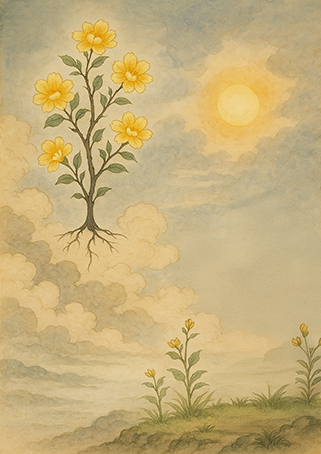Xieyi・The Rootless Tree:24 Chapters-Appendix II#287

The poems of “The Rootless Tree” express a fundamental force rooted in harmony with heaven and earth, the cyclical flow of yin and yang, and the infinite potential of existence。
This painting is an expressive Xieyi in the tradition of “futu” (spiritual diagrams), passed down for generations in Wudang Mountain, China. It is drawn through a technique where energy flow (xingqi) channels the internal intention into visual form。 In the Taoist world, there exist spiritual and symbolic images called “futu”。
In the Taoist world, there exist spiritual and symbolic images called “futu”。
These are a type of talisman—not merely religious items, but expressive spiritual paintings that act directly on the mind of the viewer。
Since ancient times, many people have placed these Taoist-style “Xieyi” and futu in their homes, studies, or bedrooms, wishing for longevity, health, auspiciousness, and family harmony. Viewing such paintings was not just aesthetic appreciation, but an act of inviting the presence of the Dao into one’s life and tuning the body and mind。
Thus, “Xieyi” is more than artistic expression—it is a medium that bridges the spirit, life, and harmony with the universe。
This kind of artwork is not meant to be seen only with the eyes, but felt with the heart。
It communicates with the Dao, resonates with the qi of nature, and quietly stirs the viewer’s inner self。
Futu and “Xieyi” continue to live on from ancient times to this day as “sacred images that speak to the soul.”
Below, we present the original text of the philosophical poem “The Rootless Tree,” along with a modern Japanese translation and interpretation。
※ The author of “The Rootless Tree,” Zhang Sanfeng (1247–?), is also renowned as the founder of Tai Chi, and it is said that he applied the essence of this work to Tai Chi. As an additional note, we include an interpretation connecting this to the Tai Chi tradition of Wudang Mountain.
Details of Tao Code, Feng Shui and talismans in Xieyi Painting
The composition is solemn and refined: dense ink grounding the root, ascending into luminescent gold and gentle mist. The brushwork channels the idea that true vitality emerges not from outward excess, but from subtle, concentrated growth. This painting invites the viewer to discern the unspoken rhythm of nature’s stillness and awaken to the inner transformation.
This artwork embodies “Ascending Longevity Qi” — the upward, refined energy of cultivation, clarity, and subtle power. It is ideally placed in a study, tea room, or contemplation space where true refinement and tranquility are sought. The golden tones belong to the Metal element, refining clarity and precision, while the dark-to-light gradient cleanses stagnation and calls forth renewal.
May this painting serve as a silent talisman — a visual vessel of Qi that carries the seed of immortality into your space, merging spirit, art, and intention.
The Rootless Tree・Appendix II

▶Original Text
無根樹,花正芳,早被東君發一陽。抽芽秀,結花房,休把仙苗作等閒。
蟾光灑處靈芝長,水浸金蓮玉作房。摘來嚐,味無雙,端的長生不老方。
▶Modern Translation
The rootless flower is fragrant. Already, the Eastern Lord sends the first yang.
It buds, blossoms, and forms clusters. The sacred seedling must not be despised.
When moonlight pours down, lingzhi mushrooms sprout, and golden lotuses bloom like jade.
Pluck and taste—it is unparalleled in flavor, truly an elixir of immortality.
▶Interpretation
• Emphasizes early cultivation and reverence for spiritual beginnings.
• Lingzhi and golden lotus symbolize health, clarity, and long life.
▶Interpretation related to Tai Chi
Early repetition of forms (like nurturing a seedling) leads to deep transformation.
Inner qi circulation, like moonlight nurturing lingzhi, yields vitality and longevity.
Copyright © MASAKI WAKABAYASHI. All rights reserved.




